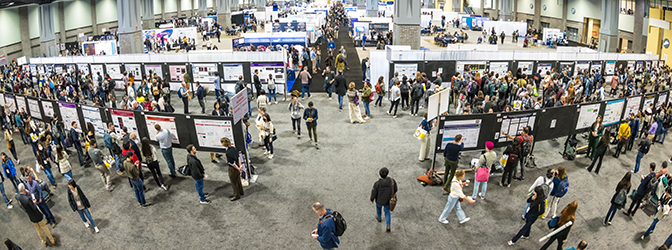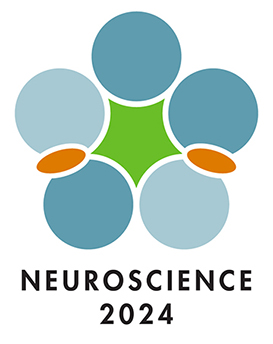Call for Abstracts
Abstract Submission Now Closed

Abstracts were received from thousands of members from all over the world. Presenting authors of abstracts will be emailed in July regarding their abstract’s acceptance status.
There are several things that can be done to prepare for the annual meeting.
- Print receipts: Log in to your SfN account to print a receipt for membership fees. Email program@sfn.org to request a copy of your $165 abstract submission fee receipt.
- Update abstract author blocks: Accepted abstracts will have a three-week period in July where the author block of the abstract can be edited. Learn more.
- Review abstract presentation formats: Learn more about abstract presentation formats and virtual posters.
- Review registration information: Remember, payment of the $165 abstract handling fee does not include registration for the annual meeting. Abstract presenters must register in order to present at the annual meeting.
- Request a visa letter of invitation: If you will be traveling to Neuroscience 2024 from outside the United States, review visa information and start gathering required travel documents.
Join our email list to receive annual meeting updates.
NEW: Late-Breaking Abstracts
In order to showcase the most recent and exciting science at Neuroscience 2024, this year SfN is experimenting with holding a second call for abstracts. Abstracts submitted during this second window are referred to as late-breaking abstracts. Late-breaking abstracts will be accepted July 23–August 1. Learn more about late-breaking abstracts.
Quick Links

Abstract Information
-
Notice of Abstract Acceptance Status
Communications regarding abstracts are sent to presenting authors only. Other co-authors should ask their abstract's presenting author for information regarding their abstract. Presenting authors will be notified about their abstract's acceptance status in July.
Advance registration for members opens on July 10. Abstract presenters must register in order to present at the annual meeting.
-
Co-Authors
All co-authors included on abstract author blocks are now required to have a free My SfN account.
In July, accepted abstracts will have a three-week period where the author block of the abstract can be edited.
-
Webinars
Watch on demand the How to Organize a Nanosymposium for Neuroscience 2024 webinar.
Register for the How to Make and Present a Poster for Neuroscience 2024 webinar taking place on August 12, 9–10 a.m. EDT.
-
Sessioning Process
Abstracts are reviewed and assigned to topically-based sessions by the SfN Program Committee. Abstract submitters can use linking groups to suggest other presenters that they would like to be grouped with in a session.
-
Presentation Formats
Abstract presentations are accepted into either poster or nanosymposia sessions.
-
Trainee Professional Development Award
The Trainee Professional Development Award (TPDA) recognizes undergraduate students, graduate students, and postdoctoral fellows who demonstrate scientific merit and excellence in research.
The TPDA application period has closed. Applicants will be notified of their acceptance by the end of August.
-
Themes and Topics
Accepted abstracts are organized into topically-based scientific sessions and Theme J sessions. Abstracts are grouped together based on the theme and topic that abstract submitters select from the Themes and Topics list during abstract submission. Theme and topic selections help the Program Committee to group abstracts; they do not represent the titles of annual meeting sessions.
-
Abstract Length
The body of the abstract should be no more than 2,300 characters, including punctuation but not spaces. Use this range as a frame of reference, then count characters and revise accordingly.
Use standard abbreviations. When using abbreviations for chemical compounds, spell it out in full for the first mention, followed by the abbreviation in parentheses. Do not abbreviate compounds in the abstract title. -
Scientific Rigor in Annual Meeting Presentations
Accepted abstract presenters will be expected to transparently report a study’s experimental design and analytical methods in their poster or nanosymposium presentation at the annual meeting. Efforts to ensure scientific rigor include blinding, statistics, sample sizes, and replication. Error bars should be defined. Biological variables such as species, sex, age, strain, or cell line should be noted in the presentation, if applicable.
-
Justify Your Abstract Presentation
Download this letter to help secure your participation at Neuroscience 2024.
Abstract Submission Policies
Rules for Abstract Submissions
Read over the rules for submitting an abstract to Neuroscience 2024.
Abstract Licensing Agreement
Review the terms of use agreed to when submitting an abstract for Neuroscience 2024.
Embargo Policy
Review SfN's embargo policy.

















